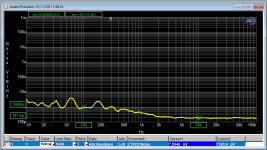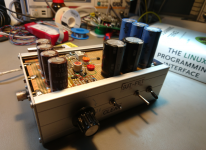Interesting. Can you tell us more about it?
I give credit to Wojtek:
http://www.janascard.cz/PDF/Design of ultra low noise amplifiers.pdf
I used 4x ZTX851, and a ZTX951 and adjusted the resistor values to get the optimum collector current per Horowitz and Hill. It's not quite where it should be but the results in terms of noise and gain come very close to the simulations (save for the low freq energy floating around the bench.)
The Z in is really low but Mr. Self in one of his books has a great idea for a very (very) low noise buffer with Zin in MOhms.
Hi, if you wonder why it's so silent over here: I have made some progress on the
phase noise measurement front by selecting, filtering & amplifying some reference
crystal ovens for cross correlation measurement, still only -168 dBc, 10 more to come...
Then I've built the noise measurement circuit from AOE3 with the obviously
needed improvements that it also works for FETs with negative gate bias. Required
switches to reverse the electrolytics and that wiring caught a lot of interference.
Finally added a few 100 uF ceramic directly at the base and used a SMD relay
to switch the 60 Ohm noise resistor in the base. That finally made it useable.
The 166000 uF to short the base to GND are mechanically too big and collect
all the dirt.
Also that 3 -stage C-Multiplier from the AOE3 circuit was no help when used with a
R&S NGT 20 triple power supply. To much wire loops. I had to move to 18 NiMH
cells that float.
But then my Agilent 89441A FFT analyzer started again to misbehave; my hope is that
it's the LAN software interface. So this Saturday I began to move my measurement
program from LAN to GPIB/IEEE-488. At least I can now talk to the Prologix
GPIB-USB dongle when I KNOW it is /dev/ttyUSB0. The rest SHOULD be easy,
it was essentially SCPI over TCP/IP. But if no one listens any more, then you cannot
pull INTERFACE CLEAR on TCP/IP.
Cheers, Gerhard
phase noise measurement front by selecting, filtering & amplifying some reference
crystal ovens for cross correlation measurement, still only -168 dBc, 10 more to come...
Then I've built the noise measurement circuit from AOE3 with the obviously
needed improvements that it also works for FETs with negative gate bias. Required
switches to reverse the electrolytics and that wiring caught a lot of interference.
Finally added a few 100 uF ceramic directly at the base and used a SMD relay
to switch the 60 Ohm noise resistor in the base. That finally made it useable.
The 166000 uF to short the base to GND are mechanically too big and collect
all the dirt.
Also that 3 -stage C-Multiplier from the AOE3 circuit was no help when used with a
R&S NGT 20 triple power supply. To much wire loops. I had to move to 18 NiMH
cells that float.
But then my Agilent 89441A FFT analyzer started again to misbehave; my hope is that
it's the LAN software interface. So this Saturday I began to move my measurement
program from LAN to GPIB/IEEE-488. At least I can now talk to the Prologix
GPIB-USB dongle when I KNOW it is /dev/ttyUSB0. The rest SHOULD be easy,
it was essentially SCPI over TCP/IP. But if no one listens any more, then you cannot
pull INTERFACE CLEAR on TCP/IP.
Cheers, Gerhard
Attachments
Last edited:
You can get the 'clone" HP GPIB usb interfaces from china pretty cheap. And even though clone they are essentially perfect copies and seem to work. That can open up access to more software you don't need to write yourself.
I broke down and got an NI GPIB ENET-100 ethernet interface which works very reliably despite NI's driver challenges.
It would seem that measuring phase noise below -170 dBC is not easy. I'll leave that to those who are more committed to the task.
I broke down and got an NI GPIB ENET-100 ethernet interface which works very reliably despite NI's driver challenges.
It would seem that measuring phase noise below -170 dBC is not easy. I'll leave that to those who are more committed to the task.
Oh, I do have an original HP/Agilent from the times when clones did not exist, and
another one from Capital Equipment (?) but I did not want to dive into interrupt
jumpers and finding the correct Linux driver.
I can now talk to the FFT analyzer. There were some trap doors, like all commands
to the dongle must be lower case and most of the documentation they point to
is 3rd party, like that from Ulrich Bangert, 7470 emulator, Plottergeist or whatever.
Another point to watch was that the tty connection must be set to RAW, no char
substitution for popular terminals, and no echo. When the PC echoes everything
the dongles says and the dongle passes the echoes to the analyzer, that makes
a real mess. I noted that when I saw on the screen of the 89441A that "Agilent"
was a bad command when I asked for instrument identification.
But still the spectra I get into the PC look weird, even a fat signal from the 3325B
fun generator shows noise. I have opened the 89441A low frequency box, it is built
like a tank.
I did download the service manual, but it only goes down to the unit level.
another one from Capital Equipment (?) but I did not want to dive into interrupt
jumpers and finding the correct Linux driver.
I can now talk to the FFT analyzer. There were some trap doors, like all commands
to the dongle must be lower case and most of the documentation they point to
is 3rd party, like that from Ulrich Bangert, 7470 emulator, Plottergeist or whatever.
Another point to watch was that the tty connection must be set to RAW, no char
substitution for popular terminals, and no echo. When the PC echoes everything
the dongles says and the dongle passes the echoes to the analyzer, that makes
a real mess. I noted that when I saw on the screen of the 89441A that "Agilent"
was a bad command when I asked for instrument identification.
But still the spectra I get into the PC look weird, even a fat signal from the 3325B
fun generator shows noise. I have opened the 89441A low frequency box, it is built
like a tank.
I did download the service manual, but it only goes down to the unit level.
Hi Jack,
what do you mean with "it cooks"? Did you increase the collector current of the ZTX' that much? If so, which value are you around? I simulated the opamp version (second schematic in the pdf) and it runs about 1.8mA. Would it be wise to increase the collector current when paralleling input devices?
what do you mean with "it cooks"? Did you increase the collector current of the ZTX' that much? If so, which value are you around? I simulated the opamp version (second schematic in the pdf) and it runs about 1.8mA. Would it be wise to increase the collector current when paralleling input devices?
- Status
- This old topic is closed. If you want to reopen this topic, contact a moderator using the "Report Post" button.
- Home
- Design & Build
- Equipment & Tools
- My lowest noise amplifier

